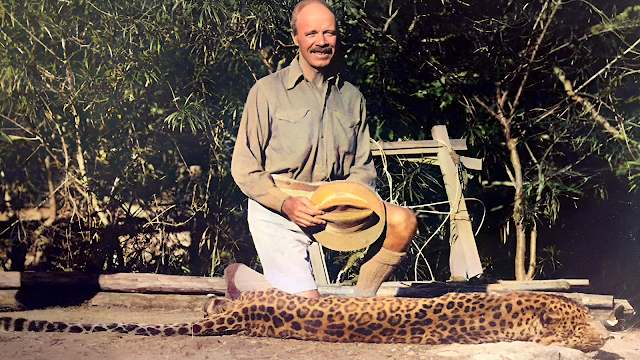Jim Corbett: A Symbol of Wildlife Conservation
July 25 marks the birthday of the legendary British hunter Jim Corbett, who became a symbol of wildlife conservation. Born in Nainital, Uttarakhand, in 1875, Corbett began his legacy as a hunter specializing in killing man-eating tigers and leopards that terrified local populations in northern India. In the early 20th century, the area of Champawat was home to a tigress sometimes referred to as the "Champawat Devil" and "the man-eater of Champawat." With a documented total of 436 human kills, the Champawat tigress holds the record for the highest number of human fatalities caused by an animal.
Typically, tigers do not attack humans, but it is said that once they taste human flesh, they become addicted to it. The story of the man-eating tigress in Champawat began not in India, but in neighboring Nepal in the late 1890s. At that time, hunters primarily targeted tigers, and not every tiger shot was killed; some survived with injuries.
It is believed that the man-eating tigress in Champawat was shot in the face, resulting in broken teeth on the right side, which made it difficult for her to hunt her usual prey. Consequently, like other man-eating beasts, she began to seek easier prey—humans.
It is unclear when the man-eating tigress began attacking people in the village of Rubal in western Nepal, but villagers soon noticed a sudden increase in the number of people disappearing into the jungle. The tiger's attacks became so frequent that villagers thought there was more than one tiger attacking them. Multiple hunting expeditions were launched, but they all failed because the tigress was more cunning and intelligent than any tiger they had encountered before. Eventually, after 200 confirmed human kills, Nepalese forces joined the hunt, but they too were unable to kill her.
However, a massive hunting party, including hunters and local volunteers, managed to track the tigress across the Sarda River into India. In the Kumaon region of Uttarakhand, the tigress continued her attacks, primarily around Champawat and nearby villages. Most of her attacks occurred during the day, with the majority of victims being women or young girls who ventured into the jungle or approached it to gather fodder for their livestock.
In India, there were also several attempts to hunt her, with large rewards offered to hunters for ending her reign of terror and absolute brutality, but she consistently outsmarted them, traveling great distances at night between villages and forests after each kill.
Unlike many hunters who had tried to pursue the man-eater in Champawat, Jim Corbett was not a professional hunter, but he was knowledgeable about the forests and animals and knew how to take one down if necessary. In 1907, a friend, a high-ranking British official aware of Corbett's hunting skills and extensive jungle experience, approached him for help in tracking down and killing the man-eating tigress in Champawat for a monetary reward.
Corbett accepted the challenge, but with two conditions: the bounty on the man-eater had to be withdrawn because he did not want to do it for money, and all other hunting parties had to be disbanded. Once his conditions were met, Corbett began the hunt for the man-eater from the village of Bali, where the tigress had just killed her documented human victim number 435.
Even during Corbett's pursuit, the man-eater struck again, this time in Champawat, attacking a woman gathering firewood peacefully. Corbett followed the blood trail into the jungle and found himself face-to-face with the enormous beast for the first time, aiming his rifle at the tigress but missing the shot. Startled by the gunshot, the tigress retreated into the forest while Corbett withdrew to the village.
Shortly thereafter, with help from the local headman, Corbett gathered a team of volunteers from the village tasked with making loud banging noises to force the tigress out of her hiding place. The loud banging indeed disturbed the tigress, prompting her to emerge from the bushes and walk directly toward where Corbett and the headman were waiting with their rifles.
After aiming and waiting for the tigress to appear, the moment came again for Corbett to eliminate this terrifying predator. He missed his first shot but hit her with the second and third shots, which, however, were not enough to kill her, leaving her in great pain and fury.
Having run out of ammunition in his rifle at that moment, Corbett took the rifle from the local headman and aimed it again at the tigress, who was now charging toward him in a frenzy, seeking revenge. Corbett fired once more, and this time it was fatal, finally bringing down the man-eater of Champawat.
A close examination of the tigress's corpse revealed that she was missing her upper and lower canines on the right side, likely due to a previous gunshot wound, which had forced her to turn to man-eating. In contrast, the killing of the Champawat tigress elevated Corbett to a level of celebrity, and he was soon sought out from other parts of the country to hunt man-eaters and rampaging beasts there.
In the following years, Corbett continued to hunt more man-eating tigers, with stories similar to that of the Champawat tigress, where a prior injury made them incapable of taking down stronger prey, leading them to hunt humans as easier targets.
This indiscriminate hunting of young cubs, whether out of fear or revenge, resulted in a dangerously low population of tigers in the wild. Consequently, Corbett began to prevent other hunters from their barbaric killing methods and defended the environment in that area. He later helped establish Hailey National Park in Kumaon, which is considered the first national park in India. He left India in 1947 after independence and settled in Kenya, where, in recognition of his work, Hailey National Park was renamed Corbett National Park in 1957.

Comments
Post a Comment